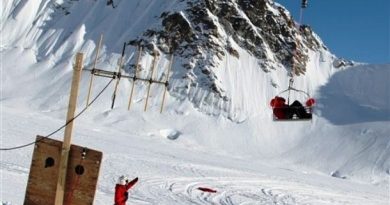Armed with technology, Jonrowe bids for elusive Alaska Iditarod win
 WILLOW — Seeing a dog outlined in bright pinks and purples on a TV screen at the home of veteran dog driver DeeDee Jonrowe might not surprise anyone familiar with the racer.
WILLOW — Seeing a dog outlined in bright pinks and purples on a TV screen at the home of veteran dog driver DeeDee Jonrowe might not surprise anyone familiar with the racer.
But Jonrowe, famous for her love of all things pink, was engrossed in the image — an infrared scan of one of her top Iditarod dogs.
The tops of the dog’s shoulders were brighter red than the rest of him. For Jonrowe, the reason was obvious.
“That’s a very hard pulling dog,” Jonrowe said. “I’m not surprised he’s sore.”
Precursor of injury?
As Judith Reese of Raven Infrared went over more scans, Jonrowe was enamored, but not surprised by what she saw. More blood flow on the certain side of a dog? Jonrowe already knows that’s because the dog favors a specific side.
Despite being only weeks from the start of her 31stIditarod and busy as ever, Jonrowe, 59, still had time for Reese and assistant to come out to her kennel to map her dogs. The idea is to create a digital library of the animals. More blood flow in an area could mean an injury, likely one in its early stages. The technology might be something race veterinarians could deploy during races — a quick way to see where the dogs are beginning to struggle and possibly address injuries before they worsen.
The technology is also something that can be deployed to detect breast cancer, an issue important to Jonrowe, 59, who was diagnosed with the disease in 2002.
Upgrades and cutting-edge dog care developments are a theme for Jonrowe. Beside the infrared scans, Jonrowe built a “dog roadhouse” this summer — a garage with indoor dog houses — to keep her animals warm and resting to their potential.
“I’m constantly in a mood of trying to learn and improve,” she said from her home Willow earlier this week.
Jonrowe is one the Iditarod’s biggest names. She bills herself as the “foremost female dog musher competing in the world today,” and her successes include 15 top-10 Iditarod finishes — including second in 1993 and 1998.
But an Iditarod championship remains elusive. Despite wins in the Copper Basin 300 and Klondike 300, Jonrowe has never captured the Iditarod.
And after three decades of dog driving, the prospect of winning still drives her, especially in a state where “men are men and women win the Iditarod,” according to the familiar refrain that first popped up on T-shirts after Libby Riddles become the first female winner in 1985, immediately followed by Susan Butcher’s four championships in five years. But Jonrowe says that’s not a “shirt” she’s ready to wear yet.
“I’ll wear it when I win it.”
Taking home the trophy?
After Aliy Zirkle’s second place finish in 2012, race fans and insiders have the started speculating over who the next female champ will be. Butcher, a four-time champion was the last woman to do so, 23 years ago in 1990. Zirkle and Jonrowe, with their second-place finishes, have been the closest women to the top podium since then.
However, Jonrowe will tell you it’s not about being the best female racer — it’s about being the best musher, man or woman. Period.
So is this the year for the veteran dog driver?
Returning are most of the 14 dogs she took to Nome a year ago when she finished 10th, her best finish in six years and the third-fastest of her career. Only two starters were sent home last season, one because she went into heat and another who developed breathing issues in Cripple.
But her pool of race dogs is deep. Beyond her finishers is a second Iditarod team driven by handler Jaimee Kinzer last year. That gives Jonrowe a pool of 24 dogs from which to choose.
Both of her main leaders, Dragon and Omnistar, are back. She feels a deep connection to the team, important in a race where the partnership between dogs and driver is crucial. The team has several full puppy litters, Jonrowe said.
Jonrowe herself is as fit as ever. While she admits that her weakness lies in her upper body — due to the surgeries that were part of her breast cancer treatment — no one could call her out of shape. She ran three half-marathons over the last year, including her first in winter — a race in Willow that followed the Iditarod trail when temperatures dipping down to minus-32 at times.
For all her physical fitness, Jonrowe said the most important part of her success lies in family support, and it’s been an emotional year for that. Both of Jonrowe’s parents are undergoing cancer treatment — her mother, Peg Stout, 84, for breast cancer and her father, Ken, 85, for metastatic melanoma.
“I’m hoping I can show them a championship” this year when she crosses Nome’s burled arch, she said.
Contact Suzanna Caldwell at suzanna(at)alaskadispatch.com
For more stories from Alaska Dispatch, click here



